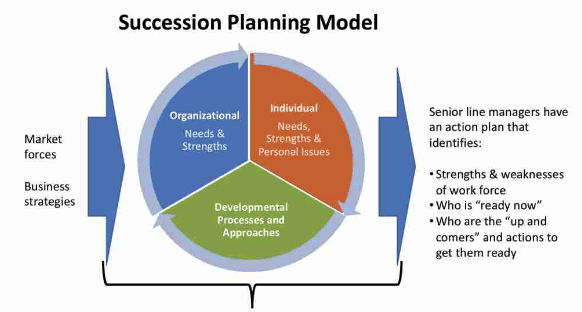Succession Planning | Crash Course for UGC NET Commerce PDF Download
What is Succession Planning?
 Succession planning is a strategic approach used by businesses to ensure a smooth transition of leadership roles to other employees when key individuals leave, retire, or pass away. This strategy ensures the continuity of business operations without disruption and can facilitate the transfer of ownership to rising employees. Succession planning is important for preparing and advancing employees at all levels, not just those in management or executive positions.
Succession planning is a strategic approach used by businesses to ensure a smooth transition of leadership roles to other employees when key individuals leave, retire, or pass away. This strategy ensures the continuity of business operations without disruption and can facilitate the transfer of ownership to rising employees. Succession planning is important for preparing and advancing employees at all levels, not just those in management or executive positions.
Key Points
- Succession planning involves preparing employees to take on leadership roles, ensuring business continuity.
- It ensures smooth operations after key employees leave or retire.
- Cross-training employees is crucial for developing their skills, knowledge, and understanding of the business.
- Plans can be long-term to prepare for future changes or for emergencies in case of unexpected departures.
- Effective succession planning can promote workforce diversity and inclusivity.
Understanding Succession Planning
Succession planning is an ongoing process, not a one-time event. It should be reviewed and updated regularly as the company evolves. The process involves assessing the skills of current leaders, identifying potential successors both within and outside the organization, and training these candidates to be ready to take over when needed.
In large organizations, the board of directors and the CEO typically oversee succession planning, which impacts owners, employees, and shareholders. Larger companies may focus on grooming mid-level employees for higher-level roles, while small businesses and family-owned companies often prepare the next generation to take over.
This process requires significant time and effort, including:
- Recruitment and Hiring: Selecting candidates with the potential to advance within the company, possibly bringing in experienced individuals from outside.
- Training: Developing employees' skills, knowledge of the company, and obtaining necessary certifications. Cross-training in various departments helps employees become well-rounded and prepares them to run the company. It also helps identify those who may not be suited for leadership roles.
Businesses may implement different types of succession plans. An emergency succession plan is for unexpected leadership changes, while a long-term plan prepares the company for anticipated leadership transitions.
Succession planning emphasizes preparation over pre-selection. The goal is to identify and develop the skills, practices, and knowledge needed for future leaders. Although the process can be complex, organizing and planning ahead can make it manageable, typically taking 12 to 36 months to complete.
Special Considerations
In a business partnership, one effective approach to succession planning is for each partner to purchase a life insurance policy that designates the other partner as the beneficiary. This is known as a cross-purchase agreement, and it allows the surviving partner to continue operating the business. Here's how it works: if one partner passes away and the surviving partner lacks the necessary funds to buy the deceased partner's ownership stake, the life insurance payout provides the capital to facilitate the purchase.
Benefits of Succession Planning
A formalized succession plan offers numerous advantages for both employers and employees:
- Employees are aware of potential advancement and ownership opportunities, which can increase their sense of empowerment and job satisfaction.
- A well-structured plan reinforces employees' career development by outlining future growth opportunities.
- Management's focus on succession planning ensures that supervisors mentor employees, passing down valuable knowledge and expertise.
- The company gains better insight into employee value, allowing for internal promotions when vacancies arise.
- Both leadership and employees align more closely with the company's values and vision.
- A new generation of leaders becomes essential as a significant number of employees retire.
- For shareholders of public companies, succession planning is particularly beneficial when a respected successor is identified and integrated into business operations well before the current CEO retires. This continuity helps maintain investor confidence and reduces the likelihood of stock sell-offs.
- Succession planning also provides an exit strategy for business owners looking to sell their stake, while cultivating the next generation of leaders.
Succession Planning and Diversity
The success of any company, large or small, increasingly depends on its inclusivity. Companies are recognizing that diversifying their workforce is essential to staying competitive and successful. Not only does a diverse environment boost employee morale, but it also expands the talent pool and helps combat bias.
To achieve this, companies must implement a robust succession plan that prioritizes hiring people from different backgrounds, with diverse leadership abilities and unique experiences. This plan should also address and remove any internal barriers that may hinder the advancement of employees at all levels, fostering a welcoming and supportive workplace for everyone.
However, for this approach to be effective, the commitment to succession planning must be genuine, rather than a superficial attempt to enhance the company’s image.
How Does Succession Planning Work?

Succession planning enables businesses to manage leadership or ownership changes more smoothly. It involves identifying internal employees who are ready for career advancement and providing them with the necessary training to step into new roles. These plans are most effective when businesses actively prepare for the future. Succession plans are typically long-term to address inevitable changes, but emergency plans should also be developed for unexpected shifts.
What is Succession Planning in Business?
Succession planning is crucial for ensuring the smooth operation of a business when leadership transitions occur. These changes can arise when employees leave for new opportunities, switch careers, retire, or in the event of unexpected circumstances such as death or a key team member's sudden departure.
Common Mistakes in Succession Planning
Effective succession planning requires careful organization and foresight. Companies often encounter challenges or make mistakes when they fail to communicate their vision to employees, neglect to formalize a plan or agreement (which should include a shortlist of potential successors and regular evaluations), assume that their talent pool is fully prepared to advance, overlook the importance of planning for all employees, or fail to prioritize diversity in their succession strategies.
|
157 videos|236 docs|166 tests
|
FAQs on Succession Planning - Crash Course for UGC NET Commerce
| 1. What is succession planning and why is it important in business? |  |
| 2. What are some common mistakes to avoid in succession planning? |  |
| 3. How does succession planning work in practice? |  |
| 4. What are some benefits of succession planning for businesses? |  |
| 5. What special considerations should businesses keep in mind when implementing succession planning? |  |





















